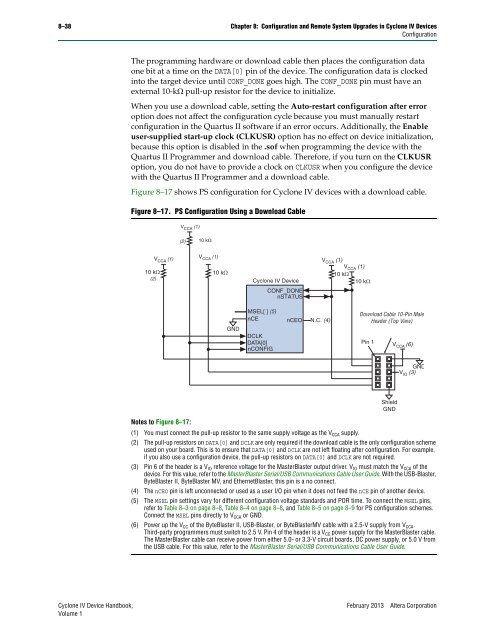Configuration and Remote System Upgrades in Cyclone IV ... - Altera
Configuration and Remote System Upgrades in Cyclone IV ... - Altera
Configuration and Remote System Upgrades in Cyclone IV ... - Altera
Create successful ePaper yourself
Turn your PDF publications into a flip-book with our unique Google optimized e-Paper software.
8–38 Chapter 8: <strong>Configuration</strong> <strong>and</strong> <strong>Remote</strong> <strong>System</strong> <strong>Upgrades</strong> <strong>in</strong> <strong>Cyclone</strong> <strong>IV</strong> Devices<br />
<strong>Configuration</strong><br />
The programm<strong>in</strong>g hardware or download cable then places the configuration data<br />
one bit at a time on the DATA[0] p<strong>in</strong> of the device. The configuration data is clocked<br />
<strong>in</strong>to the target device until CONF_DONE goes high. The CONF_DONE p<strong>in</strong> must have an<br />
external 10-k pull-up resistor for the device to <strong>in</strong>itialize.<br />
When you use a download cable, sett<strong>in</strong>g the Auto-restart configuration after error<br />
option does not affect the configuration cycle because you must manually restart<br />
configuration <strong>in</strong> the Quartus II software if an error occurs. Additionally, the Enable<br />
user-supplied start-up clock (CLKUSR) option has no effect on device <strong>in</strong>itialization,<br />
because this option is disabled <strong>in</strong> the .sof when programm<strong>in</strong>g the device with the<br />
Quartus II Programmer <strong>and</strong> download cable. Therefore, if you turn on the CLKUSR<br />
option, you do not have to provide a clock on CLKUSR when you configure the device<br />
with the Quartus II Programmer <strong>and</strong> a download cable.<br />
Figure 8–17 shows PS configuration for <strong>Cyclone</strong> <strong>IV</strong> devices with a download cable.<br />
Figure 8–17. PS <strong>Configuration</strong> Us<strong>in</strong>g a Download Cable<br />
10 kΩ<br />
(2)<br />
V CCA (1)<br />
V CCA (1)<br />
(2)<br />
Notes to Figure 8–17:<br />
10 kΩ<br />
V CCA (1)<br />
10 kΩ<br />
GND<br />
<strong>Cyclone</strong> <strong>IV</strong> Device<br />
MSEL[ ] (5)<br />
nCE<br />
DCLK<br />
DATA[0]<br />
nCONFIG<br />
CONF_DONE<br />
nSTATUS<br />
VCCA (1)<br />
VCCA (1)<br />
10 kΩ<br />
10 kΩ<br />
Download Cable 10-P<strong>in</strong> Male<br />
Header (Top View)<br />
V CCA (6)<br />
(1) You must connect the pull-up resistor to the same supply voltage as the VCCA supply.<br />
(2) The pull-up resistors on DATA[0] <strong>and</strong> DCLK are only required if the download cable is the only configuration scheme<br />
used on your board. This is to ensure that DATA[0] <strong>and</strong> DCLK are not left float<strong>in</strong>g after configuration. For example,<br />
if you also use a configuration device, the pull-up resistors on DATA[0] <strong>and</strong> DCLK are not required.<br />
(3) P<strong>in</strong> 6 of the header is a VIO reference voltage for the MasterBlaster output driver. VIO must match the VCCA of the<br />
device. For this value, refer to the MasterBlaster Serial/USB Communications Cable User Guide. With the USB-Blaster,<br />
ByteBlaster II, ByteBlaster MV, <strong>and</strong> EthernetBlaster, this p<strong>in</strong> is a no connect.<br />
(4) The nCEO p<strong>in</strong> is left unconnected or used as a user I/O p<strong>in</strong> when it does not feed the nCE p<strong>in</strong> of another device.<br />
(5) The MSEL p<strong>in</strong> sett<strong>in</strong>gs vary for different configuration voltage st<strong>and</strong>ards <strong>and</strong> POR time. To connect the MSEL p<strong>in</strong>s,<br />
refer to Table 8–3 on page 8–8, Table 8–4 on page 8–8, <strong>and</strong> Table 8–5 on page 8–9 for PS configuration schemes.<br />
Connect the MSEL p<strong>in</strong>s directly to VCCA or GND.<br />
(6) Power up the VCC of the ByteBlaster II, USB-Blaster, or ByteBlasterMV cable with a 2.5-V supply from VCCA. Third-party programmers must switch to 2.5 V. P<strong>in</strong> 4 of the header is a VCC power supply for the MasterBlaster cable.<br />
The MasterBlaster cable can receive power from either 5.0- or 3.3-V circuit boards, DC power supply, or 5.0 V from<br />
the USB cable. For this value, refer to the MasterBlaster Serial/USB Communications Cable User Guide.<br />
<strong>Cyclone</strong> <strong>IV</strong> Device H<strong>and</strong>book, February 2013 <strong>Altera</strong> Corporation<br />
Volume 1<br />
nCEO<br />
N.C. (4)<br />
P<strong>in</strong> 1<br />
Shield<br />
GND<br />
GND<br />
V IO (3)
















